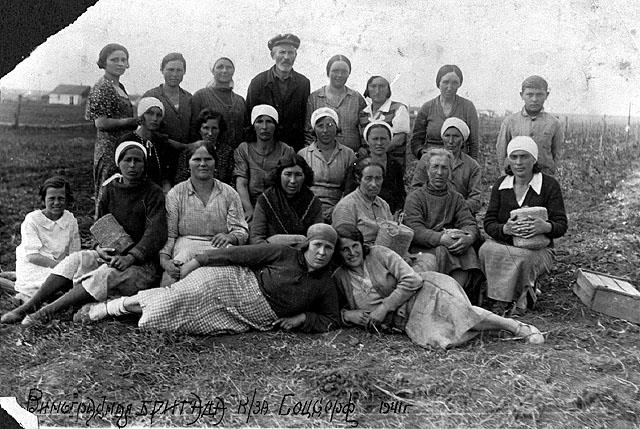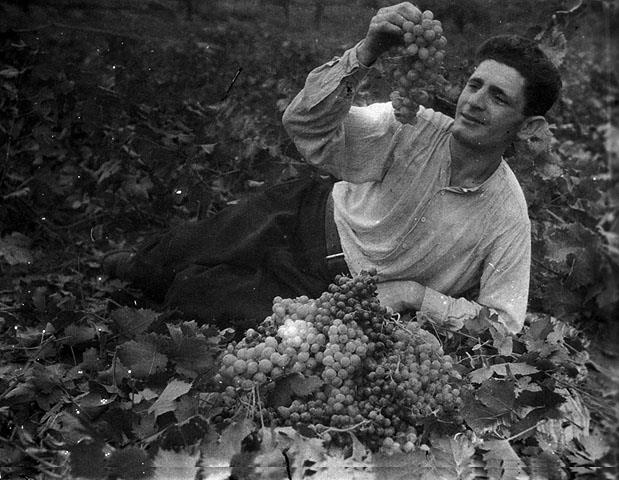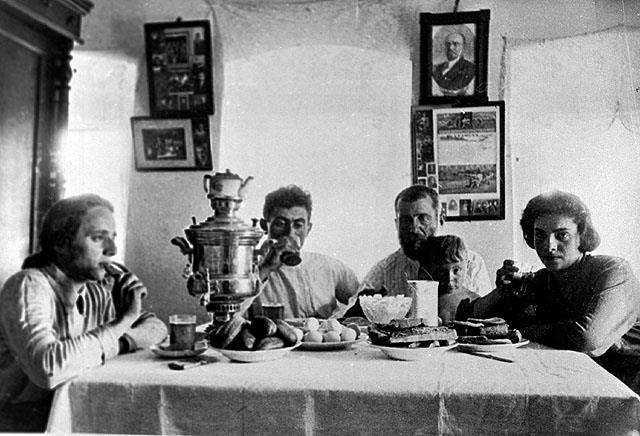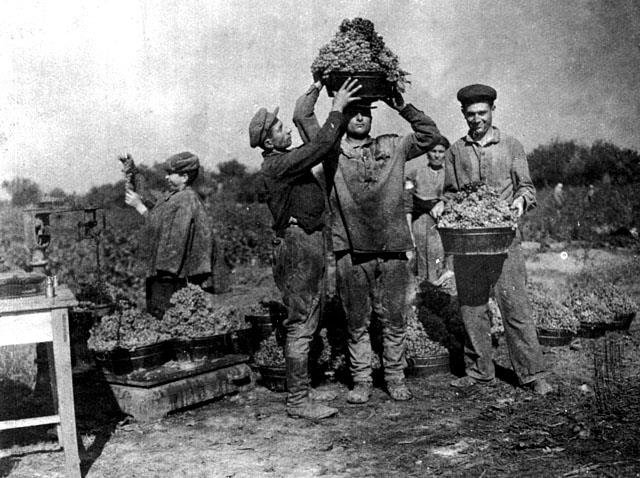In the first years following the October Revolution, the new Soviet State was suffering from a famine. The attempt to contain a ‘new economic policy’ was a big failure, and people living in cities and villages were forced to stand in line for hours to buy basic commodities such as bread, salt, matches and heating oil. And if they were lucky, they would also get a bit of herring.
Despite the famine, the communist regime continued to export grain to other countries, hoping to convey to the outside world that it was a success story. One of those images of success had to do with the kolkhozes – a contraction in Russian for collective farms. The members of a kolkhoz received no wages, but shared what they produced and the profits received from the government. Outwardly, it appeared idyllic, but in practice the Soviet authorities confiscated almost everything possible from the kolkhozes – grain, meat, chickens, eggs and more – leaving the farmers to starve. Everything was meant to benefit the Five-Year Plan and accelerated industrialization in the cities.

To begin delving into the story of the Jewish kolkhozes, we’ll go back in time. Before Poland was annexed by Russia at the end of the 18th century, hardly any Jews lived in the Russian Empire. Following the annexation, Czarina Catherine II created the Pale of Settlement – an area to which the Jews were confined and the only place in the empire where they were allowed to live. But Russia also had to populate the new territories it had occupied, and particularly in the Ukrainian plains and Crimean Peninsula. Consequently, the Jews were permitted to buy land in the annexed territories and establish agricultural colonies there. They received tax breaks, subsidies, and an exemption from military service. However, in 1866, Czar Alexander II forbid Jews from engaging in agriculture, abolished all the benefits they had been entitled to, and dismantled the colonies. The Jewish colonies were left on their own and their residents made a living working as artisans, raising farm animals, trading in goods and selling merchandise at fairs.
Following the October Revolution in 1917, the Czarist regime was overthrown, and along with it many of its decrees were also abolished, including the Pale of Settlement. Young Jews who had not been drafted into the army flocked to the cities, where they were able to study and work. Despite the pathos-filled slogans, such as “power to the workers, land to the peasants,” the Soviet authorities found it difficult to rule in the outlying territories. The State was scarred from World War I and the pogroms continued just like they did before the revolution. Additionally, the new regime called anyone who was not contributing to the communist state an “exploiter” and took away their civil rights. In 1922, after the war ended, Jews who had not emigrated to the United States or Palestine began making their way to the region of the Crimean Peninsula and southern Ukraine. Some joined the already existing Jewish colonies there, while others set up ‘spontaneous’ agricultural colonies.
Over the next two years, hardly any assistance was received from the government and the colonies largely depended on foreign philanthropists and the American Joint Distribution Committee. The new settlers and the members of communes that had been formed by the HeHalutz movement managed to cultivate the land and achieved quite a few accomplishments. In 1924, the American Joint Distribution Committee signed a number of agreements with the Kremlin concerning Jewish settlement in Soviet territories. For the Soviet authorities, it was a very convenient arrangement because they were able to absolve themselves of responsibility for dealing with the Jews. Consequently, under the aegis of the Joint, they even agreed to provide the settlers with free land, fuel and other assistance, in addition to cutting their taxes during the transition period. For the Jews, it was a worthwhile deal because under Soviet law agriculture was considered ‘productive work’ – which meant that the rights they had been stripped of could be restored. In its heyday, the Joint Distribution Committee’s agricultural corporation (Agro-Joint) employed more than 1,000 workers, with offices from Moscow to the Crimean Peninsula.

The aid package extended by Agro-Joint included the provision of tractors, technical advice, vocational training, and low-interest loans to the settlers and their non-Jewish neighbors who lived near the Black Sea. The primary aim of the assistance given to the non-Jews was to ensure that the new Jewish settlers would receive a warm welcome and not be subject to pogroms.
Thanks to their hard work and the support received from the Joint Distribution Committee, the Jewish farmers managed to achieve a standard of living that was much higher than that of an average Russian peasant. At the time, the Agro-Joint project also had an adverse impact on Zionist attempts to increase Jewish settlement in Palestine. At one point, the number of Jewish settlers in Ukraine was four times higher than the number of settlers who went to Palestine.
There is no way of knowing how things would have turned out if the Jews had established an independent republic in the Crimean Peninsula. In any event, the Soviet authorities began collectivizing the Jewish farms in 1929 – namely, they nationalized what already belonged to the State. At first, it was mostly poor people who joined those kolkhozes, who were looking to improve their economic status. More affluent farm owners opposed the collectivization, but were forced to accept it or be accused of being Zionists and petit bourgeois. Many were exiled to Siberia and the Far East after all their property was nationalized.
By 1931, nearly all the Jewish farms were converted into nationalized kolkhozes. The official Soviet propaganda praised the alleged rewarding and happy life the members led. In practice, they were required to comply with the draconian demands defined in the Five-Year Plan, which meant handing over virtually the entire yield of their crops to the State. If a kolkhoz failed to meet the targets set for it, the authorities would confiscate the members’ remaining food, including food items from the shops. The confiscators even made a point of going from house to house to check if anything was left in the storerooms and pantries.

The Great Famine – the Holodomor – started in 1932-1933. Because the Soviet state was never satisfied with what it received from the farmers, it had no problem starving them and the small towns in Ukraine. Besides wanting to feed the people living in the big Russian cities, the authorities also sought to sell grain from the kolkhozes to Western countries, and by doing so keep up communist appearances around the world.
The farmers on the kolkhozes were not the only ones who were hungry. All the artisans living in Ukrainian cities faced the same fate. Orders for their goods stopped and the stands in the farmers markets were empty. All Ukrainians were hungry, including of course the Jews. The following is testimony from that period: “As for the Eskowitz family from Berdichev, the parents died of hunger, leaving three children aged 4, 8 and 11 to fend for themselves and go from house to house begging for charity.”
Regardless of the famine and its numerous victims, the authorities continued to confiscate grain from the kolkhozes. Local representatives of the government were not allowed to publicize the outcomes of the official policy. Nonetheless, one representative of the Communist Party reported the following to the Vinnitsa regional committee, located in central Ukraine: “Despite your ban on reporting the number of people who have died of starvation, I believe it would be a crime not to advise you of the situation. In the town of Ulanov – most of whose residents are Jewish – there are about 95 hungry people. As of April 20, 1933, 35 have already died of hunger.”

We still do not know the exact number of people who died of hunger during that period. The ‘official’ number ranges from 2.2 million to 3.9 million, including the Jewish population.
The purges began at about the same time. The press reported “thefts and malicious damage committed by the enemies of communism” – which kept the Soviet kolkhozes from thriving. In 1938, the organized settlement of Jews in the Crimean Peninsula and southern Ukraine came to a halt after the authorities merged the Jewish kolkhozes with the other ones. That decision led many Jews to leave due to the adverse effect it had on their traditional way of life. They also found it difficult to comply again with new and harsh rules.
The Joint Distribution Committee left the Soviet Union in 1938. Of the 14,000 Jewish families who populated the region during the years in question, some returned to the cities. Most of those who stayed behind were killed in the Holocaust following the German invasion.